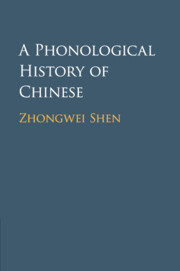Book contents
- A Phonological History of Chinese
- A Phonological History of Chinese
- Copyright page
- Contents
- Figures
- Tables
- Foreword by William S-Y. Wang 王士元
- Preface
- Major Periods of Chinese History
- Locations of Ancient Capitals of China
- Part I The Keys to Traditional Phonology
- Part II Old Chinese
- Part III Middle Chinese
- Part IV The Beginnings of Mandarin
- 5 The Chinese of the Liao, Jin, and Xixia Dynasties
- Part V A New Standard
- Part VI Toward Modern Mandarin
- References
- Index
5 - The Chinese of the Liao, Jin, and Xixia Dynasties
from Part IV - The Beginnings of Mandarin
Published online by Cambridge University Press: 09 June 2020
- A Phonological History of Chinese
- A Phonological History of Chinese
- Copyright page
- Contents
- Figures
- Tables
- Foreword by William S-Y. Wang 王士元
- Preface
- Major Periods of Chinese History
- Locations of Ancient Capitals of China
- Part I The Keys to Traditional Phonology
- Part II Old Chinese
- Part III Middle Chinese
- Part IV The Beginnings of Mandarin
- 5 The Chinese of the Liao, Jin, and Xixia Dynasties
- Part V A New Standard
- Part VI Toward Modern Mandarin
- References
- Index
Summary
The use of the term "Mandarin" did not start until the time of the Ming dynasty (1368–1644), but the phonological features of Mandarin can be traced to the time of the Liao dynasty (916–1125) and the Song dynasty (960–1127). While the Qièyùn phonology as a national standard was artificially kept in use for the imperial examination and poetry composition, a sound system of a colloquial language-based standard had been developing in northern China. This system, which became the direct ancestral language of Modern Mandarin, can be traced to the tenth century. The transition of the national standard from the Middle Chinese of the Sui–Tang time to the Old Mandarin of the Yuan time was not just a change of the phonological system in time, but more importantly it was a change of a geographical dialect. From the tenth century on, the northern dialects, represented by the dialect of the modern Beijing area, gradually gained its standard status. The new phonological standard of the Yuan dynasty (1279–1368) was a continuation of the phonological standards of the Chinese language spoken in the territories of the Liao and Jin.
Keywords
- Type
- Chapter
- Information
- A Phonological History of Chinese , pp. 197 - 228Publisher: Cambridge University PressPrint publication year: 2020



